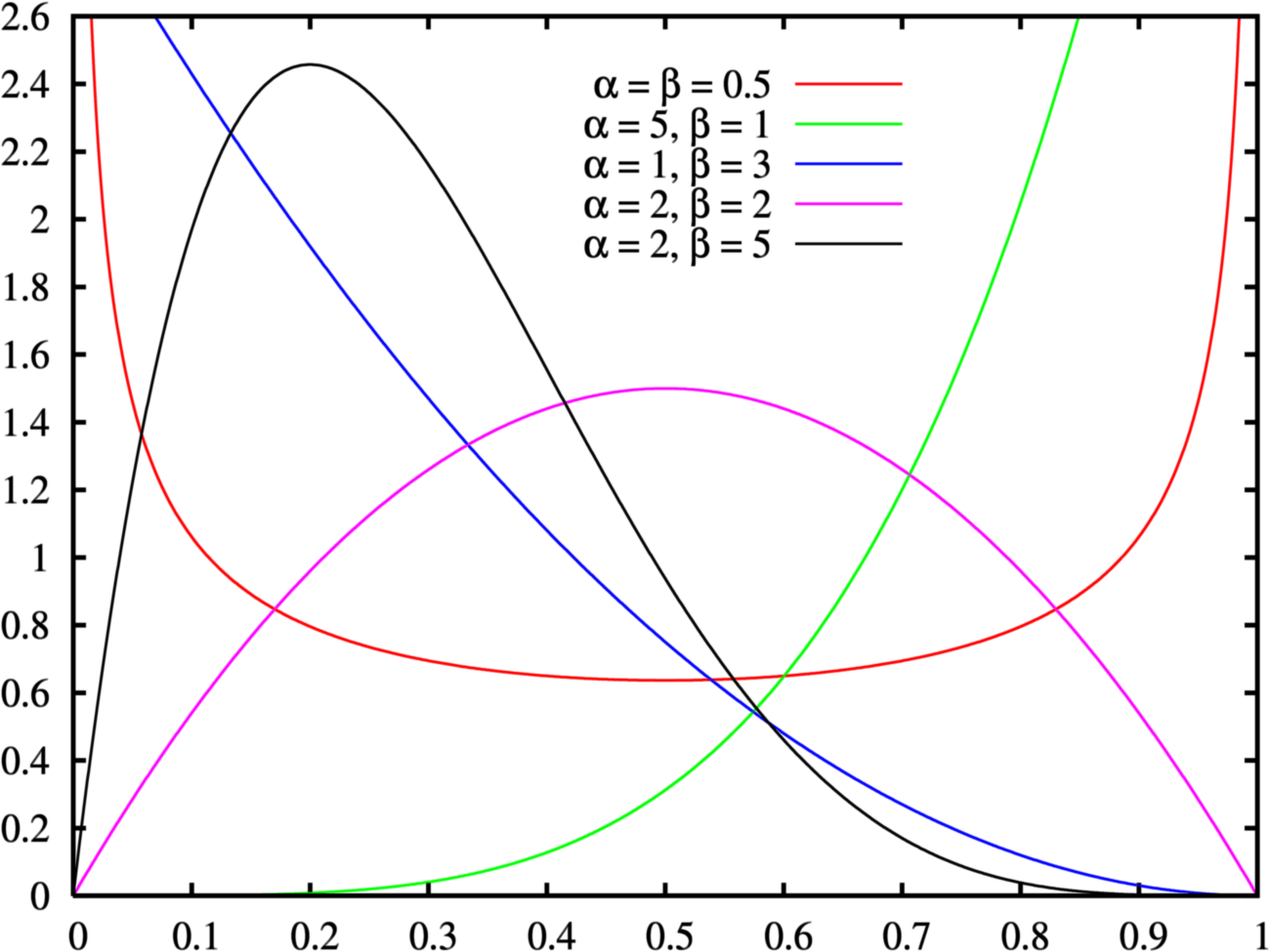Is there some restriction to parameters $( \alpha , \beta)$ that makes the beta distribution concave down? Bell-shaped like e.g. a normal?
For example, the cases in purple and black, but not the red green or blue cases:

Is there some restriction to parameters $( \alpha , \beta)$ that makes the beta distribution concave down? Bell-shaped like e.g. a normal?
For example, the cases in purple and black, but not the red green or blue cases:

In the context of a beta distribution, I would regard "bell-shaped" as meaning that there exist exactly two distinct inflection points in the interval $(0,1)$ with a global maximum in between, and $f(0) = f(1) = 0$ where $$f(x) \propto x^{a-1} (1-x)^{b-1}.$$ We clearly aren't interested in the proportionality constant in this case. The condition that $f(0) = f(1) = 0$ obviously requires $a > 1$, $b > 1$. Now via logarithmic differentiation, we obtain $$f'(x) \propto x^{a-2} (1-x)^{b-2}(a-1+(2-a-b)x),$$ so our local maximum occurs at $x = \frac{a-1}{a+b-2}.$ Then $$f''(x) \propto x^{a-3} (1-x)^{b-3} ((a-1)(a-2) + 2(a-1)(3-a-b)x + (3-a-b)(2-a-b)x^2),$$ which will have two distinct real zeroes if the discriminant of the quadratic factor is positive: $$(2(a-1)(3-a-b))^2 - 4(3-a-b)(2-a-b)(a-1)(a-2) > 0.$$ This is equivalent to $$(a-1)(b-1)(a+b-3) > 0.$$ Since we already established that $a, b > 1$, we then obtain another condition: $a + b > 3$. However, we are still not done: we must now check that the inflection points are in $(0,1)$. To do this, it suffices to check that $\displaystyle \lim_{\epsilon \to 0^+} f''(\epsilon) > 0$ and similarly $\displaystyle \lim_{\epsilon \to 0^+} f''(1-\epsilon) > 0$: the first condition requires $(a-1)(a-2) > 0$, hence $a > 2$, and similarly, the second requires $(b-1)(b-2) > 0$, or $b > 2$. (A symmetry argument would also suffice.) Therefore, the beta PDF could be said to be "bell-shaped" whenever $a > 2$ and $b > 2$.
What we usually call a "bell-shaped" graph, is neither concave (or "concave down") nor convex (or "concave up") -it has both concave and convex parts.
For the Beta density to be (strictly) concave everywhere, its second derivative with respect to its variable must be negative. The probability density function is
$$f_X(x)=\frac{x^{\alpha-1}(1-x)^{\beta-1}} {B(\alpha,\beta)},\;\;\;\ B(\alpha,\beta) = \int_0^1t^{\alpha-1}(1-t)^{\beta-1}\,\mathrm{d}t$$
We compute that
$$f'_X(x) = f_X(x)\left(\frac {\alpha-1}{x} - \frac {\beta-1}{1-x}\right)$$
and
$$f''_X(x) = f'_X(x)\left(\frac {\alpha-1}{x} - \frac {\beta-1}{1-x}\right) - f_X(x)\left(\frac {\alpha-1}{x^2} + \frac {\beta-1}{(1-x)^2}\right)$$
$$\Rightarrow f''_X(x) = f_X(x)\left(\frac {\alpha-1}{x} - \frac {\beta-1}{1-x}\right)^2 - f_X(x)\left(\frac {\alpha-1}{x^2} + \frac {\beta-1}{(1-x)^2}\right)$$
So
$$\text{sign}\{f''_X(x)\}=\text{sign}\left\{[(\alpha-1)(1-x)-(\beta-1)x]^2- (\alpha-1)(1-x)^2-(\beta-1)x^2\right\}$$
$$=\text{sign}\left\{(\alpha-1)(\alpha-2)(1-x)^2+(\beta-1)(\beta-2)x^2- 2(\alpha-1)(\beta-1)x(1-x)\right\}$$
We see that when
$$\{1<\alpha\leq 2\}\cap\{1<\beta \leq 2\}$$
the above is certainly negative irrespective of the value of $x$ (and so the density graph will be concave for the whole of its domain).
The strict concavity result also holds if one of the parameters is equal to $1$, while the other is strictly between $1$ and $2$ (but then one endpoint of the graph won't reach zero. Still the density will be strictly concave). I don't think there is any other range of the parameters for which strict concavity holds. To play around a web-graph facility is http://keisan.casio.com/exec/system/1180573226
D) and making it a function also suggests there's a problem with your answer, since yours changes sign for cases when doing it via D doesn't.) -- I think that $1<\alpha,\beta\leq 2$ does it
$\endgroup$
I surmise that what you really mean is the density goes to zero at both the endpoints. For this, you need $\alpha > 1$ and $\beta > 1$. The closer that $\alpha$ and $\beta$ are to each other, the closer the distribution will be to symmetrical.